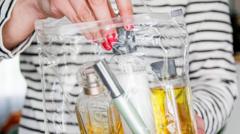Will the 100ml Airport Liquid Rule Stay in Place?

The Future of Liquid Restrictions in Air Travel: What Passengers Need to Know
In a significant shift for air travel, some airports are beginning to introduce new technology that could revolutionize the way we carry liquids in our hand luggage. However, with the Transport Secretary advising passengers to continue adhering to the existing 100ml liquid limit, it leaves many travelers confused about what to expect. This article dives deep into the recent changes at Birmingham and Edinburgh airports, the implications for air travelers across the UK, and the broader context of liquid restrictions in air travel.
The Current Landscape of Liquid Restrictions
For nearly two decades, the 100ml rule has been a staple of air travel security. This limitation was introduced in 2006, following heightened concerns about aviation security after the tragic events of September 11, 2001. Since then, passengers have been required to comply with stringent regulations concerning liquids, gels, and aerosols, which must be stored in containers of no more than 100ml and placed in a clear, resealable plastic bag.
Despite the long-standing nature of these regulations, recent advancements in security technology are paving the way for potential changes. The introduction of new CT X-ray scanning machines at select airports offers a glimpse into a future where such restrictions could be relaxed. However, the rollout of this technology is inconsistent, leaving travelers in a state of uncertainty.
New Developments at Birmingham and Edinburgh Airports
Recently, Birmingham and Edinburgh airports have begun implementing advanced scanning technology that allows passengers to carry liquids in containers up to two liters. This represents a substantial increase from the previous restriction and could significantly enhance the travel experience.
How the New Scanners Work
The new scanners utilize sophisticated CT X-ray technology, which provides enhanced imaging capabilities compared to traditional systems. This technology allows security personnel to more accurately assess the contents of bags without requiring passengers to remove their liquids for separate inspection.
Some of the benefits of the new CT X-ray scanners include:
- Increased Capacity: Passengers can bring larger bottles of liquids, which is especially beneficial for those traveling with children or on long-haul flights.
- Streamlined Security Process: No more fumbling with plastic bags or worrying about exceeding the 100ml limit.
- Enhanced Security: The advanced imaging technology allows for better detection of potential threats.
Challenges in Implementation
Despite the promising advancements, the installation of these scanners is not without its challenges. The process is complex and costly, requiring significant modifications to airport infrastructures. In some cases, airports have had to reinforce floors to accommodate the heavy machinery.
Moreover, the availability of the scanners is limited, with only a few manufacturers producing them, which has led to delays in installation at various airports. As a result, the rollout has been described by industry insiders as "haphazard," highlighting the lack of a cohesive approach to updating liquid policies across airports.
Advice from the Transport Secretary
Transport Secretary Heidi Alexander has emphasized the importance of adhering to the current regulations while the transition to new technology is underway. She advises passengers to "work on the basis that it is 100ml at the moment unless you have heard from your airport otherwise." This means that travelers should remain vigilant and check with their airlines and airports for the latest updates on security procedures prior to their trips.
The Role of AirportsUK and Government Policies
AirportsUK has acknowledged the evolving nature of aviation security procedures concerning liquids. They have advised that changes will occur at different times across various airports, reflecting the inconsistent rollout of the new scanning technology. This lack of uniformity can lead to confusion among travelers, particularly those flying into or out of multiple airports.
International Considerations
The inconsistency is not limited to the UK. Across Europe, the rollout of new scanning technology has also faced challenges. Last summer, the European Union had to revert to the 100ml limit due to a technical issue with new equipment. This highlights the difficulties faced by the aviation sector in implementing updated security measures uniformly.
The Future of Air Travel and Liquid Restrictions
As we look to the future, it is clear that the landscape of air travel is changing. The introduction of advanced scanning technology offers the potential for a more relaxed approach to liquid restrictions, but this is contingent on successful implementation across airports. Here are some potential scenarios for the future of liquid restrictions:
- Widespread Adoption: If airports successfully implement the new scanning technology, we could see a gradual lifting of the 100ml rule, allowing passengers to carry larger quantities of liquids without the hassle of plastic bags.
- Continued Limitations: If challenges persist in the rollout, it is possible that the 100ml limit will remain in place for an extended period, resulting in ongoing frustration for travelers.
- Enhanced Security Measures: Regardless of changes to liquid restrictions, it is likely that security measures will continue to evolve to address emerging threats in aviation.
What Should Passengers Do Now?
For travelers planning to fly in the near future, the best course of action is to stay informed. Here are some practical tips:
- Check Airport Websites: Regularly visit the official websites of the airports you will be using to get the latest updates on security procedures.
- Contact Airlines: Reach out to your airline for specific guidance on liquid policies and what to expect at security checkpoints.
- Plan Ahead: If you are uncertain about the rules at your departure airport, consider packing any liquids in compliance with the 100ml rule as a precaution.
Conclusion: A New Era for Air Travel?
As airports like Birmingham and Edinburgh take the lead in adopting new scanning technology, the future of liquid restrictions in air travel remains uncertain yet hopeful. The potential for enhanced traveler convenience is tantalizing, but the inconsistent rollout raises questions. For now, passengers should remain cautious and informed as they navigate this evolving landscape.
As we move forward, how will these changes impact your travel experience? Will you embrace the new technology, or are you still wary about the security implications? The future of air travel is in flux, and it’s up to us, the passengers, to adapt and stay informed.
Frequently Asked Questions
What is the current liquid limit for hand luggage on flights?
The current limit for liquids in hand luggage is 100ml per container, and all liquids must fit within a single clear, resealable plastic bag.
Which airports have changed their liquid policies recently?
Birmingham and Edinburgh airports have introduced new scanning technology that allows passengers to carry liquids in bottles up to two liters.
Why were liquid restrictions introduced in the first place?
The 100ml liquid restriction was introduced in 2006 as part of enhanced security measures following terrorist incidents, particularly after the events of 9/11.
How can passengers prepare for potential changes in liquid restrictions?
Travelers should check the latest security procedures at their departure airport, stay in contact with their airlines, and prepare to comply with the existing regulations until notified otherwise.
As air travel continues to evolve, how do you feel about the potential relaxation of liquid restrictions? Will it change the way you pack for your next trip? #AirTravel #LiquidRestrictions #TravelSafety
Published: 2025-07-08 13:05:08 | Category: technology



